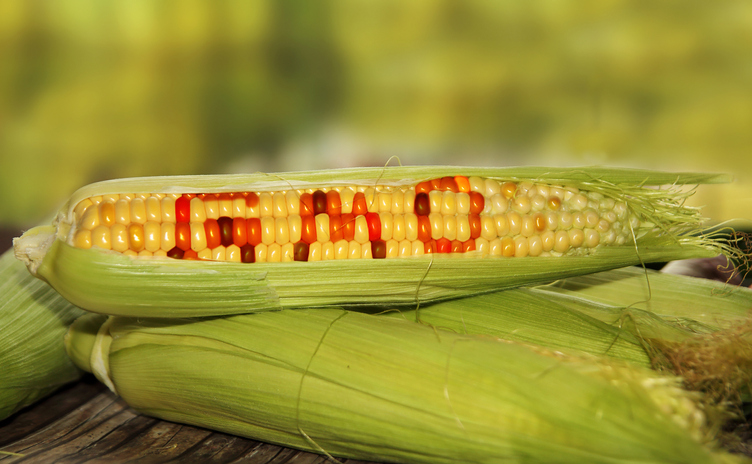This topic takes on average 55 minutes to read.
There are a number of interactive features in this resource:
 Biology
Biology
 PSHE / Citizenship studies
PSHE / Citizenship studies
 Science (applied)
Science (applied)
Genetic engineering can be used in three main types of organism: micro-organisms, plants, and animals.
The most well-known examples of genetically engineered micro-organisms produce therapeutic proteins for medical treatments, but recombinant bacteria have also been developed that can extract metal from ore. This type of genetic engineering is well established, and the risks are well controlled. Few people express any concerns about the use of genetically modified (GM) microorganisms to make human medicines or vaccines. Unfortunately, the biochemistry of prokaryotes means that there is a limit to the complexity of the molecules they can make – so microorganisms cannot solve all of our medical problems.
Transgenic plants are also relatively common. Many crops are grown in the US with a specific herbicide or pesticide resistant gene added. For example, 85% of the soybeans grown in the US, and 98% of the soybeans grown in Argentina are GM crops. Organisations such as the International Rice Research Institute (IRRI) are working to develop strains of rice which are resistant to extreme weather conditions resulting from climate change such as flooding or dryness. Making crop plants more efficient, or more nutritious, through genetic modification, offers a way of meeting the food needs of the ever-growing human population.

Scientists are also looking to develop nutritionally enriched strains of rice and other staple foods such as cassava and sweet potatoes. These offer a way of preventing some of the many deficiency diseases which have devastating impacts on the health of millions of people around the world (see paragraph on golden rice). GM plants also have the potential to deliver medicines in a way which is particularly valuable in the developing world. Work is well underway on growing GM plants which contain specific drugs, vaccines and even monoclonal antibodies. Over 3 million people die every year from vaccine-preventable diseases, mainly in the developing world – if a locally grown food crop can be engineered to deliver the vaccines which are needed, many lives could be saved.
Another category of transgenic plants is biopharm crops, which contain a substance of medical value that could replace a pharmaceutical product. For example, genetically modified plants are being produced that contain vaccines. In future these vaccines should be inexpensive, easy to deliver to remote areas and could even be orally administered without specialist technology. However, there are concerns that wildlife could be poisoned by eating biopharm crops. Recombinant vaccines have already been produced in micro-organisms: yeast is used to produce a vaccine for hepatitis B. A specific protein on the surface of the hepatitis B virus triggers an immune response when it infects humans; this protein is produced by genetically engineered yeast cells grown in culture, from which the protein can be easily extracted and purified. This is relatively cheap and safe - the virus is not present when the protein is produced and so there is no chance of an accidental infection, unlike the previous method of producing a vaccine which involved purifying the blood of humans and animals infected with the disease. However, it is hard to get enough vaccine from the yeast cells. GM potatoes which can grow the hepatitis B vaccine are now being investigated.
In spite of many years of safe use of GM crops such as soybeans, some people still have concerns about these new biotechnologies, including fears that:
wildlife could be poisoned though the overuse of herbicides on genetically engineered herbicide-resistant crops.
the herbicide-resistant transgene could transfer to weeds, creating ‘super weeds.
the genetically engineered crops themselves could become superweeds by growing out of control.
Some people think the use of genetically engineered crops promotes industrial farming and creates large populations of identical genetically engineered organisms with the same unknown disease susceptibilities. Others are worried about the health risks: will new allergens be created (perhaps by inserting nut genes into other crops)? People wonder if it is possible that new toxins will be produced as inactive toxin production pathways become activated by gene insertion. Some crops are genetically engineered to be able to withstand high concentrations of toxic metal in soil and resist herbicides – but perhaps they will have high concentrations of these in their edible tissues and therefore be poisonous?
Of course, concerns must be investigated, and the use of GM plants constantly monitored, but once evidence is available to show that the process appears safe, it should be taken on board to benefit those in need. The use of GM plants generally, and especially in medicines, is well summarised in this paper from the Journal of the Royal Society of Medicine.
Biopharm – the production of medicines from biological systems – doesn’t just need GM microorganisms and plants. There is also a growing role for transgenic animals.
